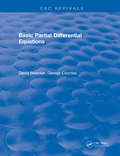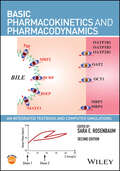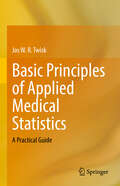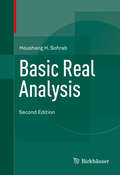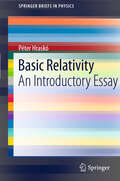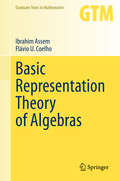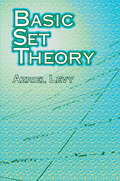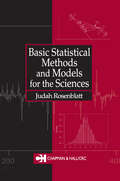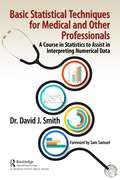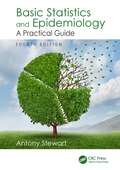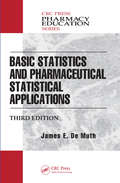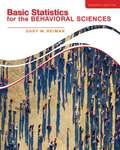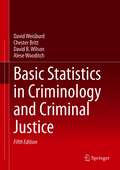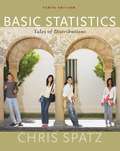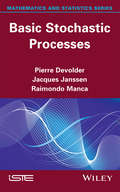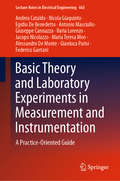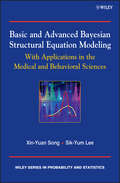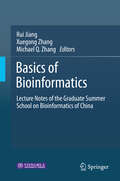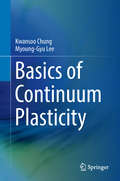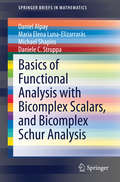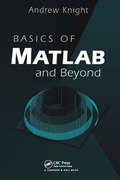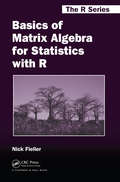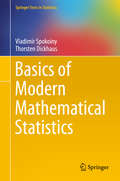- Table View
- List View
Basic Partial Differential Equations
by David. BleeckerMethods of solution for partial differential equations (PDEs) used in mathematics, science, and engineering are clarified in this self-contained source. The reader will learn how to use PDEs to predict system behaviour from an initial state of the system and from external influences, and enhance the success of endeavours involving reasonably smooth, predictable changes of measurable quantities. This text enables the reader to not only find solutions of many PDEs, but also to interpret and use these solutions. It offers 6000 exercises ranging from routine to challenging. The palatable, motivated proofs enhance understanding and retention of the material. Topics not usually found in books at this level include but examined in this text:the application of linear and nonlinear first-order PDEs to the evolution of population densities and to traffic shocksconvergence of numerical solutions of PDEs and implementation on a computerconvergence of Laplace series on spheresquantum mechanics of the hydrogen atomsolving PDEs on manifoldsThe text requires some knowledge of calculus but none on differential equations or linear algebra.
Basic Pharmacokinetics and Pharmacodynamics: An Integrated Textbook and Computer Simulations
by Sara E. RosenbaumUpdated with new chapters and topics, this book provides a comprehensive description of all essential topics in contemporary pharmacokinetics and pharmacodynamics. It also features interactive computer simulations for students to experiment and observe PK/PD models in action.* Presents the essentials of pharmacokinetics and pharmacodynamics in a clear and progressive manner* Helps students better appreciate important concepts and gain a greater understanding of the mechanism of action of drugs by reinforcing practical applications in both the book and the computer modules* Features interactive computer simulations, available online through a companion website at: http://www.uri.edu/pharmacy/faculty/rosenbaum/basicmodels.html* Adds new chapters on physiologically based pharmacokinetic models, predicting drug-drug interactions, and pharmacogenetics while also strengthening original chapters to better prepare students for more advanced applications* Reviews of the 1st edition: "This is an ideal textbook for those starting out ... and also for use as a reference book ...." (International Society for the Study of Xenobiotics) and "I could recommend Rosenbaum's book for pharmacology students because it is written from a perspective of drug action . . . Overall, this is a well-written introduction to PK/PD .... " (British Toxicology Society Newsletter)
Basic Phylogenetic Combinatorics
by Andreas Spillner Andreas Dress Katharina T. Huber Jacobus Koolen Vincent MoultonPhylogenetic combinatorics is a branch of discrete applied mathematics concerned with the combinatorial description and analysis of phylogenetic trees and related mathematical structures such as phylogenetic networks and tight spans. Based on a natural conceptual framework, the book focuses on the interrelationship between the principal options for encoding phylogenetic trees: split systems, quartet systems and metrics. Such encodings provide useful options for analyzing and manipulating phylogenetic trees and networks, and are at the basis of much of phylogenetic data processing. This book highlights how each one provides a unique perspective for viewing and perceiving the combinatorial structure of a phylogenetic tree and is, simultaneously, a rich source for combinatorial analysis and theory building. Graduate students and researchers in mathematics and computer science will enjoy exploring this fascinating new area and learn how mathematics may be used to help solve topical problems arising in evolutionary biology.
Basic Principles of Applied Medical Statistics: A Practical Guide
by Jos W. TwiskThis book describes the basic principles of medical statistics. Although there are many texts on this topic, this one is different in that it limits the mathematics to an absolute minimum. It will therefore be extremely useful for non-mathematical researchers who need to use statistical methods in their work. Here, they will learn how to choose the appropriate statistical method and how to interpret the results obtained from statistical software. An important feature of the book is that it highlights the common thread throughout the statistical methods. By understanding this common thread, the analyses become much easier to comprehend. Each chapter contains multiple examples, and because the example datasets are available, the readers can reanalyze them and practice how to perform a particular statistical analysis.
Basic Real Analysis
by Houshang H. SohrabThis expanded second edition presents the fundamentals and touchstone results of real analysis in full rigor, but in a style that requires little prior familiarity with proofs or mathematical language. The text is a comprehensive and largely self-contained introduction to the theory of real-valued functions of a real variable. The chapters on Lebesgue measure and integral have been rewritten entirely and greatly improved. They now contain Lebesgue's differentiation theorem as well as his versions of the Fundamental Theorem(s) of Calculus. With expanded chapters, additional problems, and an expansive solutions manual, Basic Real Analysis, Second Edition is ideal for senior undergraduates and first-year graduate students, both as a classroom text and a self-study guide. Reviews of first edition: The book is a clear and well-structured introduction to real analysis aimed at senior undergraduate and beginning graduate students. The prerequisites are few, but a certain mathematical sophistication is required. . . . The text contains carefully worked out examples which contribute motivating and helping to understand the theory. There is also an excellent selection of exercises within the text and problem sections at the end of each chapter. In fact, this textbook can serve as a source of examples and exercises in real analysis. --Zentralblatt MATH The quality of the exposition is good: strong and complete versions of theorems are preferred, and the material is organised so that all the proofs are of easily manageable length; motivational comments are helpful, and there are plenty of illustrative examples. The reader is strongly encouraged to learn by doing: exercises are sprinkled liberally throughout the text and each chapter ends with a set of problems, about 650 in all, some of which are of considerable intrinsic interest. --Mathematical Reviews [This text] introduces upper-division undergraduate or first-year graduate students to real analysis. . . . Problems and exercises abound; an appendix constructs the reals as the Cauchy (sequential) completion of the rationals; references are copious and judiciously chosen; and a detailed index brings up the rear. --CHOICE Reviews
Basic Relativity: An Introductory Essay (SpringerBriefs in Physics)
by Péter HraskóThis Brief presents a new way of introducing relativity theory, in which perplexing relativistic effects such as time dilation and Lorentz contraction are explained prior to the discussion of Lorentz-transformation. The notion of relativistic mass is shown to contradict the spirit of relativity theory and the true significance of the mass-energy relation is contrasted with the popular view of it. The author discusses the twin paradox from the point of view of both siblings. Last but not least, the fundamentals of general relativity are described, including the recent Gravity Probe B experiment.
Basic Representation Theory of Algebras (Graduate Texts in Mathematics #283)
by Ibrahim Assem Flávio U. CoelhoThis textbook introduces the representation theory of algebras by focusing on two of its most important aspects: the Auslander-Reiten theory and the study of the radical of a module category. It starts by introducing and describing several characterisations of the radical of a module category, then presents the central concepts of irreducible morphisms and almost split sequences, before providing the definition of the Auslander-Reiten quiver, which encodes much of the information on the module category. It then turns to the study of endomorphism algebras, leading on one hand to the definition of the Auslander algebra and on the other to tilting theory. The book ends with selected properties of representation-finite algebras, which are now the best understood class of algebras. Intended for graduate students in representation theory, this book is also of interest to any mathematician wanting to learn the fundamentals of this rapidly growing field. A graduate course in non-commutative or homological algebra, which is standard in most universities, is a prerequisite for readers of this book.
Basic Set Theory (Dover Books on Mathematics)
by Azriel LevyAlthough this book deals with basic set theory (in general, it stops short of areas where model-theoretic methods are used) on a rather advanced level, it does it at an unhurried pace. This enables the author to pay close attention to interesting and important aspects of the topic that might otherwise be skipped over. Written for upper-level undergraduate and graduate students, the book is divided into two parts. The first covers pure set theory, including the basic notions, order and well-foundedness, cardinal numbers, the ordinals, and the axiom of choice and some of its consequences. The second part deals with applications and advanced topics, among them a review of point set topology, the real spaces, Boolean algebras, and infinite combinatorics and large cardinals. A helpful appendix deals with eliminability and conservation theorems, while numerous exercises supply additional information on the subject matter and help students test their grasp of the material. 1979 edition. 20 figures.
Basic Statistical Methods and Models for the Sciences
by Judah RosenblattThe use of statistics in biology, medicine, engineering, and the sciences has grown dramatically in recent years and having a basic background in the subject has become a near necessity for students and researchers in these fields. Although many introductory statistics books already exist, too often their focus leans towards theory and few help readers gain effective experience in using a standard statistical software package.Designed to be used in a first course for graduate or upper-level undergraduate students, Basic Statistical Methods and Models builds a practical foundation in the use of statistical tools and imparts a clear understanding of their underlying assumptions and limitations. Without getting bogged down in proofs and derivations, thorough discussions help readers understand why the stated methods and results are reasonable. The use of the statistical software Minitab is integrated throughout the book, giving readers valuable experience with computer simulation and problem-solving techniques. The author focuses on applications and the models appropriate to each problem while emphasizing Monte Carlo methods, the Central Limit Theorem, confidence intervals, and power functions.The text assumes that readers have some degree of maturity in mathematics, but it does not require the use of calculus. This, along with its very clear explanations, generous number of exercises, and demonstrations of the extensive uses of statistics in diverse areas applications make Basic Statistical Methods and Models highly accessible to students in a wide range of disciplines.
Basic Statistical Techniques for Medical and Other Professionals: A Course in Statistics to Assist in Interpreting Numerical Data
by David J. SmithWe are bombarded with statistical data each and every day, and healthcare professionals are no exception. All sectors of healthcare rely on data provided by insurance companies, consultants, research firms, and government to help them make a host of decisions regarding the delivery of medical services. But while these health professionals rely on data, do they really make the best use of the information? Not if they fail to understand whether the assumptions behind the formulas generating the numbers make sense. Not if they don’t understand that the world of healthcare is flooded with inaccurate, misleading, and even dangerous statistics. The purpose of this book is to provide members of medical and other professions, including scientists and engineers, with a basic understanding of statistics and probability together with an explanation and worked examples of the techniques. It does not seek to confuse the reader with in-depth mathematics but provides basic methods for interpreting data and making inferences. The worked examples are medically based, but the principles apply to the analysis of any numerical data.
Basic Statistics and Epidemiology: A Practical Guide, Fourth Edition (Radcliffe Ser.)
by Antony StewartBasic Statistics and Epidemiology is a straightforward primer in basic statistics that emphasizes its practical use in epidemiology and public health, providing an understanding of essential topics such as study design, data analysis and statistical methods used in the execution of medical research. Assuming no prior knowledge, the clarity of the text and care of presentation ensure those new to, or challenged by, these topics are given a thorough introduction without being overwhelmed by unnecessary detail. An understanding and appreciation of statistics is central to ensuring that professional practice is based on the best available evidence, in order to treat and help most appropriately the wider community. By reading this book, students, researchers, doctors, nurses and health managers will have the knowledge necessary to understand and apply the tools of statistics and epidemiology to their own practice.
Basic Statistics and Pharmaceutical Statistical Applications (Pharmacy Education Series)
by James E. De MuthBuilding on its best-selling predecessors, Basic Statistics and Pharmaceutical Statistical Applications, Third Edition covers statistical topics most relevant to those in the pharmaceutical industry and pharmacy practice. It focuses on the fundamentals required to understand descriptive and inferential statistics for problem solving. Incorporating
Basic Statistics for the Behavioral Sciences (Seventh Edition)
by Gary W. HeimanPacked with real-world illustrations and the latest data available, BASIC STATISTICS FOR THE BEHAVIORAL SCIENCES, 7e demystifies and fully explains statistics in a lively, reader-friendly format. The author's clear, patiently crafted explanations with an occasional touch of humor, teach readers not only how to compute an answer but also why they should perform the procedure or what their answer reveals about the data. Offering a conceptual-intuitive approach, this popular book presents statistics within an understandable research context, deals directly and positively with potential weaknesses in mathematics, and introduces new terms and concepts in an integrated way.
Basic Statistics in Criminology and Criminal Justice: Volume 1
by David Weisburd Chester Britt David B. Wilson Alese WooditchThis introductory textbook takes a building-block approach that emphasizes the application and interpretation of statistics in research in crime and justice. This text is meant for both students and professionals who want to gain a basic understanding of common statistical methods used in criminology and criminal justice before advancing to more complex statistical analyses in future volumes. This book emphasizes comprehension and interpretation. As the statistical methods discussed become more complex and demanding to compute, it integrates statistical software. It provides readers with an accessible understanding of popular statistical programs used to examine real-life crime and justice problems (including SPSS, Stata, and R). In addition, the book includes supplemental resources such as a glossary of key terms, practice questions, and sample data. Basic Statistics in Criminology and Criminal Justice aims to give students and researchers a core understanding of statistical concepts and methods that will leave them with the confidence and tools to tackle the statistical problems in their own research work.
Basic Statistics: Tales Of Distributions
by Chris SpatzLearn statistical reasoning and problem solving from a best-selling author who uses a wealth of examples from the social and behavioral sciences,, education,, nursing/allied health, and business fields--as well as examples from everyday life-to help you learn and understand. Praised for his clear explanations, Spatz shows you how to start with a data set, identify the questions it poses, determine and carry out statistical procedures, and using plain English, tell the story the data reveal.
Basic Stochastic Processes
by Jacques Janssen Raimondo Manca Pierre DevolderThis book presents basic stochastic processes, stochastic calculus including Lévy processes on one hand, and Markov and Semi Markov models on the other. From the financial point of view, essential concepts such as the Black and Scholes model, VaR indicators, actuarial evaluation, market values, fair pricing play a central role and will be presented. The authors also present basic concepts so that this series is relatively self-contained for the main audience formed by actuaries and particularly with ERM (enterprise risk management) certificates, insurance risk managers, students in Master in mathematics or economics and people involved in Solvency II for insurance companies and in Basel II and III for banks.
Basic Theory and Laboratory Experiments in Measurement and Instrumentation: A Practice-Oriented Guide (Lecture Notes in Electrical Engineering #663)
by Andrea Cataldo Nicola Giaquinto Antonio Masciullo Giuseppe Cannazza Ilaria Lorenzo Jacopo Nicolazzo Maria Teresa Meo Gianluca Parisi Federico Gaetani Egidio De Benedetto Alessando De MonteThis textbook offers a unique compendium of measurement procedures for experimental data acquisition. After introducing readers to the basic theory of uncertainty evaluation in measurements, it shows how to apply it in practice to conduct a range of laboratory experiments with instruments and procedures operating both in the time and frequency domains. Offering extensive practical information and hands-on tips on using oscilloscopes, spectrum analyzers and reflectometric instrumentation, the book shows readers how to deal with e.g. filter characterization, operational amplifiers, digital and analogic spectral analysis, and reflectometry-based measurements. For each experiment, it describes the corresponding uncertainty evaluation in detail. Bridging the gap between theory and practice, the book offers a unique, self-contained guide for engineering students and professionals alike. It also provides university teachers and professors with a valuable resource for their laboratory courses on electric and electronic measurements.
Basic and Advanced Bayesian Structural Equation Modeling
by Xin-Yuan Song Sik-Yum LeeThis book provides clear instructions to researchers on how to apply Structural Equation Models (SEMs) for analyzing the inter relationships between observed and latent variables.Basic and Advanced Bayesian Structural Equation Modeling introduces basic and advanced SEMs for analyzing various kinds of complex data, such as ordered and unordered categorical data, multilevel data, mixture data, longitudinal data, highly non-normal data, as well as some of their combinations. In addition, Bayesian semiparametric SEMs to capture the true distribution of explanatory latent variables are introduced, whilst SEM with a nonparametric structural equation to assess unspecified functional relationships among latent variables are also explored.Statistical methodologies are developed using the Bayesian approach giving reliable results for small samples and allowing the use of prior information leading to better statistical results. Estimates of the parameters and model comparison statistics are obtained via powerful Markov Chain Monte Carlo methods in statistical computing.Introduces the Bayesian approach to SEMs, including discussion on the selection of prior distributions, and data augmentation.Demonstrates how to utilize the recent powerful tools in statistical computing including, but not limited to, the Gibbs sampler, the Metropolis-Hasting algorithm, and path sampling for producing various statistical results such as Bayesian estimates and Bayesian model comparison statistics in the analysis of basic and advanced SEMs.Discusses the Bayes factor, Deviance Information Criterion (DIC), and $L_\nu$-measure for Bayesian model comparison.Introduces a number of important generalizations of SEMs, including multilevel and mixture SEMs, latent curve models and longitudinal SEMs, semiparametric SEMs and those with various types of discrete data, and nonparametric structural equations.Illustrates how to use the freely available software WinBUGS to produce the results.Provides numerous real examples for illustrating the theoretical concepts and computational procedures that are presented throughout the book.Researchers and advanced level students in statistics, biostatistics, public health, business, education, psychology and social science will benefit from this book.
Basics of Bioinformatics: Lecture Notes of the Graduate Summer School on Bioinformatics of China
by Rui Jiang Xuegong Zhang Michael Q. ZhangThis book outlines 11 courses and 15 research topics in bioinformatics, based on curriculums and talks in a graduate summer school on bioinformatics that was held in Tsinghua University. The courses include: Basics for Bioinformatics, Basic Statistics for Bioinformatics, Topics in Computational Genomics, Statistical Methods in Bioinformatics, Algorithms in Computational Biology, Multivariate Statistical Methods in Bioinformatics Research, Association Analysis for Human Diseases: Methods and Examples, Data Mining and Knowledge Discovery Methods with Case Examples, Applied Bioinformatics Tools, Foundations for the Study of Structure and Function of Proteins, Computational Systems Biology Approaches for Deciphering Traditional Chinese Medicine, and Advanced Topics in Bioinformatics and Computational Biology. This book can serve as not only a primer for beginners in bioinformatics, but also a highly summarized yet systematic reference book for researchers in this field. Rui Jiang and Xuegong Zhang are both professors at the Department of Automation, Tsinghua University, China. Professor Michael Q. Zhang works at the Cold Spring Harbor Laboratory, Cold Spring Harbor, NY, USA.
Basics of Continuum Plasticity
by Kwansoo Chung Myoung-Gyu LeeThis book describes the basic principles of plasticity for students and engineers who wish to perform plasticity analyses in their professional lives, and provides an introduction to the application of plasticity theories and basic continuum mechanics in metal forming processes. This book consists of three parts. The first part deals with the characteristics of plasticity and instability under simple tension or compression and plasticity in beam bending and torsion. The second part is designed to provide the basic principles of continuum mechanics, and the last part presents an extension of one-dimensional plasticity to general three-dimensional laws based on the fundamentals of continuum mechanics. Though most parts of the book are written in the context of general plasticity, the last two chapters are specifically devoted to sheet metal forming applications. The homework problems included are designed to reinforce understanding of the concepts involved. This book may be used as a textbook for a one semester course lasting fourteen weeks or longer. This book is intended to be self-sufficient such that readers can study it independently without taking another formal course. However, there are some prerequisites before starting this book, which include a course on engineering mathematics and an introductory course on solid mechanics.
Basics of Functional Analysis with Bicomplex Scalars, and Bicomplex Schur Analysis (SpringerBriefs in Mathematics)
by Michael Shapiro Daniel Alpay Maria Elena Luna-Elizarrarás Daniele C. StruppaThis book provides the foundations for a rigorous theory of functional analysis with bicomplex scalars. It begins with a detailed study of bicomplex and hyperbolic numbers and then defines the notion of bicomplex modules. After introducing a number of norms and inner products on such modules (some of which appear in this volume for the first time), the authors develop the theory of linear functionals and linear operators on bicomplex modules. All of this may serve for many different developments, just like the usual functional analysis with complex scalars and in this book it serves as the foundational material for the construction and study of a bicomplex version of the well known Schur analysis.
Basics of Image Processing: The Facts and Challenges of Data Harmonization to Improve Radiomics Reproducibility (Imaging Informatics for Healthcare Professionals)
by Ángel Alberich-Bayarri Fuensanta Bellvís-BatallerThis book, endorsed by EuSoMII, provides clinicians, researchers and scientists a useful handbook to navigate the intricate landscape of data harmonization, as we embark on a journey to improve the reproducibility, robustness and generalizability of multi-centric real-world data radiomic studies. In these pages, the authors delve into the foundational principles of radiomics and its far-reaching implications for precision medicine. They describe the different methodologies used in extracting quantitative features from medical images, the building blocks that enable the transformation of images into actionable predictions. This book sweeps from understanding the basis of harmonization to the implementation of all the knowledge acquired to date, with the aim of conveying the importance of harmonizing medical data and providing a useful guidance to enable its applicability and the future use of advanced radiomics-based models in routine clinical practice. As authors embark on this exploration of data harmonization in radiomics, they hope to ignite discussions, foster new ideas, and inspire researchers, clinicians, and scientists alike to embrace the challenges and opportunities that lie ahead. Together, they elevate radiomics as a reproducible technology and establish it as an indispensable and actionable tool in the quest for improved cancer diagnosis and treatment.
Basics of MATLAB and Beyond
by Andrew KnightMATLAB The tremendously popular computation, numerical analysis, signal processing, data analysis, and graphical software package-allows virtually every scientist and engineer to make better and faster progress. As MATLAB's world-wide sales approach a half-million with an estimated four million users, it becomes a near necessity that professionals a
Basics of Matrix Algebra for Statistics with R (Chapman & Hall/CRC The R Series #31)
by Nick FiellerA Thorough Guide to Elementary Matrix Algebra and Implementation in R Basics of Matrix Algebra for Statistics with R provides a guide to elementary matrix algebra sufficient for undertaking specialized courses, such as multivariate data analysis and linear models. It also covers advanced topics, such as generalized inverses of singular and rectangular matrices and manipulation of partitioned matrices, for those who want to delve deeper into the subject. The book introduces the definition of a matrix and the basic rules of addition, subtraction, multiplication, and inversion. Later topics include determinants, calculation of eigenvectors and eigenvalues, and differentiation of linear and quadratic forms with respect to vectors. The text explores how these concepts arise in statistical techniques, including principal component analysis, canonical correlation analysis, and linear modeling. In addition to the algebraic manipulation of matrices, the book presents numerical examples that illustrate how to perform calculations by hand and using R. Many theoretical and numerical exercises of varying levels of difficulty aid readers in assessing their knowledge of the material. Outline solutions at the back of the book enable readers to verify the techniques required and obtain numerical answers. Avoiding vector spaces and other advanced mathematics, this book shows how to manipulate matrices and perform numerical calculations in R. It prepares readers for higher-level and specialized studies in statistics.
Basics of Modern Mathematical Statistics: Exercises And Solutions (Springer Texts in Statistics)
by Thorsten Dickhaus Vladimir SpokoinyThis textbook provides a unified and self-contained presentation of the main approaches to and ideas of mathematical statistics. It collects the basic mathematical ideas and tools needed as a basis for more serious study or even independent research in statistics. The majority of existing textbooks in mathematical statistics follow the classical asymptotic framework. Yet, as modern statistics has changed rapidly in recent years, new methods and approaches have appeared. The emphasis is on finite sample behavior, large parameter dimensions, and model misspecifications. The present book provides a fully self-contained introduction to the world of modern mathematical statistics, collecting the basic knowledge, concepts and findings needed for doing further research in the modern theoretical and applied statistics. This textbook is primarily intended for graduate and postdoc students and young researchers who are interested in modern statistical methods.
